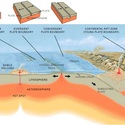Aotearoa New Zealand is a geologically active country. We feel the big jolts from earthquakes, but there are some minute Earth movements that we didn’t know were taking place beneath our feet until a couple of decades ago. Slow slips are very, very slow movements – just a few millimetres over days, weeks or months.
These small movements are monitored by a network of very sensitive GPS instruments placed around the country and the Chatham Islands. Satellites send microwave signals to the GPS receivers at these sites, enabling them to record very precise positions on the Earth’s surface. This continuous sending and receiving of data allows scientists to measure even the smallest of movements. Scientists are interested in slow slips because the small movements relieve stress in some fault lines but increase stress in others. They want to know how slow slip earthquakes and normal earthquakes are related.
This activity uses actual data from the Institute of Geological and Nuclear Sciences (GNS Science), which shows small slip Earth movements near the East Coast’s Māhia Peninsula. It is part of a suite of activities that support the Build a satellite interactive. These activities support students to engage with the science capabilities ‘Gather and interpret data’, ‘Critique evidence’ and ‘Interpret representations’.
By the end of this activity, students should be able to:
- discuss why scientists have established a monitoring system to track slow slip earthquakes
- discuss how GPS instruments and satellites are used to track very small Earth movements
- use their science capabilities to explore information about monitoring sites and the data they collect.
Download the Word file (see link below).
Related content and activity ideas
Earthquake resources – planning pathways provides pedagogical insights and curates Hub resources into key science and technology concepts.
The JOIDES Resolution research ship used expedition #375 to explore slow slips.
The activity Reading graphs in science uses a step-by-step approach to reading scientific data displays. This is similar to using comprehension strategies when teaching reading and language literacies.
Plot and interpret a graph using data from an actual slow slip event in New Zealand with Something creepy is happening.
Useful links
Learn more about slow slips in the Hawke’s Bay/Māhia Peninsula area.
Check out these GNS Science resources on slow slip earthquakes.
Acknowledgement
This resource has been produced with funding from the Ministry of Business, Innovation and Employment and the support of the New Zealand Space Agency.




